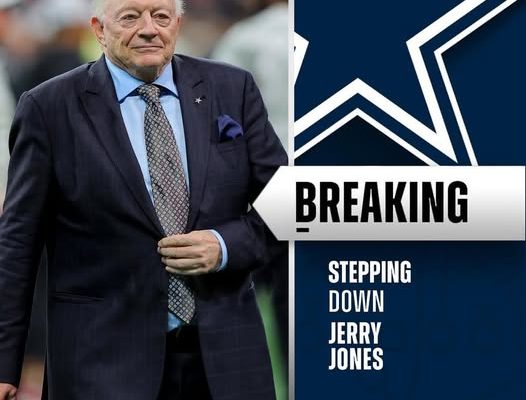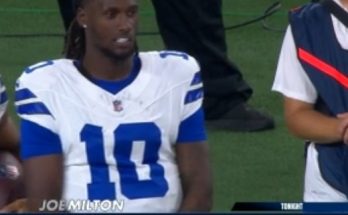The announcement that Jerry Jones, the iconic owner of the Dallas Cowboys, is stepping down from his role as General Manager has sent shockwaves throughout the NFL world. For decades, Jones has been synonymous with the Cowboys, serving not only as the team’s owner but also as its chief architect, guiding personnel decisions and shaping the very identity of America’s Team. His influence has extended far beyond the field, as he has become one of the most prominent figures in sports business, known for his bold moves, unrelenting competitiveness, and sometimes controversial management style. The decision to step down as GM marks a pivotal moment for the franchise, one that signals a new chapter in Cowboys history and raises questions about the team’s future direction.
Jerry Jones purchased the Dallas Cowboys in 1989 for \$140 million, a sum that now seems almost quaint given the team’s current valuation of over \$9 billion. From the outset, Jones demonstrated a hands-on approach, inserting himself deeply into both the business and football operations of the franchise. His tenure as GM was characterized by a combination of audacious personnel moves, high-profile draft decisions, and a willingness to shake up the organization whenever he deemed necessary. Some of these decisions resulted in immediate success, while others drew criticism from fans and analysts alike. Nevertheless, his influence was undeniable, and his fingerprints were evident on every aspect of the Cowboys’ identity—from their roster construction to their global branding.
Jones’ dual role as owner and GM was highly unusual in the NFL, where the norm has been a separation of business and football operations. While owners typically focus on revenue generation, stadium operations, and sponsorship deals, Jones consistently inserted himself into football matters, often weighing in on drafts, trades, and coaching hires. This approach produced notable highs, including three Super Bowl championships in the 1990s under the leadership of Jimmy Johnson, as well as multiple playoff appearances and periods of sustained competitiveness. However, it also brought moments of controversy, particularly in more recent years, when personnel decisions and coaching changes were publicly scrutinized.
The announcement of Jones stepping down as GM represents a calculated pivot, likely aimed at modernizing the Cowboys’ front office structure and ensuring long-term sustainability. While he will remain the owner and maintain ultimate authority over major decisions, relinquishing day-to-day control of football operations opens the door for a new era of executive leadership. This move could allow for the hiring of a General Manager with extensive experience in modern scouting, analytics, and team-building, giving the Cowboys a competitive edge in an NFL that increasingly values data-driven decision-making. By stepping back, Jones is positioning the franchise to adapt to the evolving landscape of professional football while still retaining his influential voice.
The implications of this decision are far-reaching. From a team-building perspective, the Cowboys may now be able to implement a more collaborative approach to roster construction. In the past, Jones’ direct involvement sometimes led to tensions with coaches and front-office staff, as his presence could complicate consensus-building. With a dedicated GM at the helm, decisions about draft strategy, free-agent acquisitions, and contract negotiations may become more streamlined, potentially fostering a more cohesive organizational culture. This change could also attract top-tier executive talent, individuals who previously may have been hesitant to work under an owner with such a dominant presence in football operations.
Fans of the Cowboys have experienced a roller-coaster ride under Jones’ tenure as GM. While the 1990s dynasty provided moments of elation, subsequent years have often been marked by unmet expectations and frustration over personnel choices. The team has endured periods of inconsistency, particularly in the quarterback position, and decisions regarding coaching hires and draft selections have occasionally sparked heated debate. Jones’ decision to step down may be viewed by fans as an opportunity to reset the football side of the organization, providing fresh perspectives and innovative strategies that could help the Cowboys recapture their elite status in the NFL. It also reflects an understanding that sustained success in the modern NFL requires specialized expertise and a division of responsibilities that aligns with contemporary best practices.
Beyond the team itself, Jones’ move has significant implications for the broader NFL landscape. He has long been a prominent voice among owners, known for advocating for league-wide initiatives such as revenue sharing, television contracts, and stadium financing. His reputation as a bold and sometimes unconventional leader has influenced league policies and negotiations, and his stepping back from GM duties may allow him to devote more attention to league matters. This could enhance his already substantial influence on the business and governance side of the NFL, even as he transitions responsibilities on the football side of the Cowboys’ operations.
Historically, the Cowboys have been a benchmark franchise in terms of both on-field performance and off-field business operations. Jones’ tenure as GM has intertwined both aspects, creating a model in which football success and commercial growth were pursued simultaneously. The Cowboys’ brand has become a global powerhouse, with merchandising, sponsorships, and media presence that few other teams can match. By stepping away from football operations, Jones may now be able to focus even more on the strategic growth of the franchise as a business entity, exploring new revenue streams, enhancing fan engagement, and strengthening the Cowboys’ international footprint.
While many view this transition as a positive evolution, it is not without risks. The appointment of a new GM carries the challenge of finding someone who can balance the demands of a high-profile franchise with the need to implement a long-term vision. Integrating a new executive into an organization where the owner has historically been deeply involved in football matters will require careful management and clear communication. Additionally, fans will be closely watching to see how this change impacts roster decisions, coaching stability, and overall competitiveness. Success or failure in these areas will inevitably influence public perception of Jones’ decision and the effectiveness of the new leadership structure.
The timing of Jones’ announcement also warrants consideration. The NFL is entering a period of heightened competitiveness, with teams increasingly leveraging analytics, sports science, and advanced scouting methods to gain an advantage. By stepping back now, Jones is providing the Cowboys an opportunity to embrace modern football operations and build a framework that can compete with top franchises both on and off the field. This could be especially crucial as the team navigates upcoming free-agent markets, draft cycles, and salary-cap management challenges. A well-positioned GM, supported by a capable executive team, could enable the Cowboys to make more strategic decisions and enhance their prospects for sustained success.
From a personal standpoint, stepping down as GM may also represent a new phase in Jones’ legacy. He has already cemented his place as one of the most influential owners in NFL history, with an indelible impact on the league’s culture, business operations, and competitive landscape. Relinquishing day-to-day football responsibilities does not diminish that legacy; rather, it reflects a strategic evolution in his role, allowing him to focus on mentorship, long-term planning, and broader organizational oversight. This decision may ultimately strengthen the Cowboys by combining the continuity of Jones’ ownership with the specialized expertise of a professional GM, creating a dual leadership model that aligns with contemporary organizational best practices.
The reaction to Jones’ announcement has been immediate and widespread. Analysts, former players, and fans alike have debated the potential consequences for the Cowboys, speculating on possible candidates for the GM position and how the transition might impact the team’s strategy. While opinions vary, there is a general recognition that this move represents a significant shift in the way the franchise will operate. The NFL, with its high stakes and intense scrutiny, rarely sees such dramatic structural changes in the front office of a marquee team. As such, all eyes will be on the Cowboys in the coming months to observe how this transition unfolds and what it means for the team’s competitive trajectory.
In conclusion, Jerry Jones’ decision to step down as General Manager of the Dallas Cowboys marks a historic moment for the franchise and the NFL at large. It reflects a willingness to adapt, embrace modern football management practices, and ensure the long-term sustainability of one of the league’s most storied teams. While challenges undoubtedly lie ahead, the move has the potential to rejuvenate the Cowboys’ front office, attract top executive talent, and foster a more collaborative approach to team-building. For fans, it represents both the end of an era and the beginning of a new chapter, one that could redefine the Cowboys’ identity and position them for success in the rapidly evolving landscape of professional football. Jerry Jones’ legacy as a visionary owner remains intact, and this transition underscores his commitment to ensuring that the Dallas Cowboys continue to thrive both on and off the field, solidifying his place in NFL history as a transformative figure whose influence will resonate for generations.



